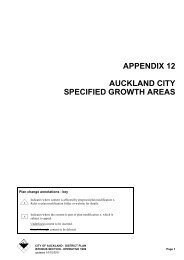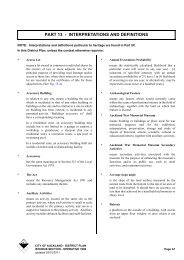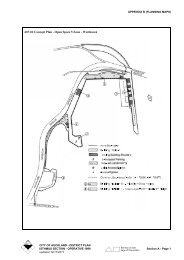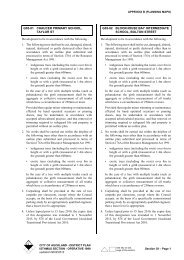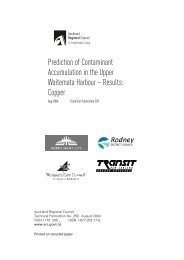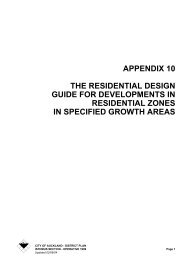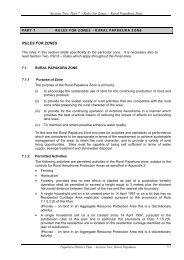North Shore Heritage Thematic Review Report ... - Auckland Council
North Shore Heritage Thematic Review Report ... - Auckland Council
North Shore Heritage Thematic Review Report ... - Auckland Council
Create successful ePaper yourself
Turn your PDF publications into a flip-book with our unique Google optimized e-Paper software.
5.1 Local Government<br />
Following the establishment of the signal station in 1841, Flagstaff was included in the Parish of Takapuna,<br />
one of the six parishes for land registration in the First Territorial District, County of Eden, in 1842. 56 In<br />
1848 the Hundred of Pupuke was created and wardens appointed to control the use of Crown „waste land‟<br />
through the licensing of animal grazing rights. (The term „hundred‟ is an English unit of local government.<br />
It was a subdivision of a shire and existed from medieval times until the 19 th century.) In 1853, as a result of<br />
the Crown subdividing and selling off most of the Crown land in Devonport, the Hundred of Pupuke was<br />
dissolved. For the next 15 years the administration was taken over by the Provincial Government.<br />
The Flagstaff District Highway Board, formed in 1866, was the first true local government elected by<br />
citizens. The board‟s initial tasks were to form roads and provide drainage. Efforts to designate some<br />
remaining Crown Land for public reserves were at first turned down, but in 1873 the Minister of Crown<br />
Lands gave Flagstaff Hill (Mt Victoria) to the citizens for recreational use. In 1876 the Board also took on<br />
the duties of a Board of Health. The Flagstaff District Highway Board opened the first library in the<br />
<strong>Auckland</strong> Provincial District in 1878, and achieved another milestone in 1882 with the installation of gas<br />
street lighting.<br />
The formation of Devonport Borough in 1886 was the result of an increase in population and reflected the<br />
growing importance of Devonport as a military, naval and commercial centre on the <strong>North</strong> <strong>Shore</strong>. As early<br />
as 1927 Devonport Borough <strong>Council</strong> resisted attempts at a forced amalgamation with the four other<br />
boroughs on the <strong>North</strong> <strong>Shore</strong>. It also resisted joining schemes for sharing electricity and water supply.<br />
Devonport residents believed that their interests in both social and commercial development were with<br />
<strong>Auckland</strong> City and not with the more rural boroughs of <strong>North</strong>cote, Birkenhead and Takapuna. It was as<br />
much a suburb of <strong>Auckland</strong> City as Mt Eden or Remuera. Further amalgamation proposals were resisted in<br />
1958 and again in 1967. 57<br />
The opening of the Harbour Bridge in 1959 affected Devonport immensely. Development and population<br />
moved north to the „bays‟, the suburb began to decline, and the <strong>Council</strong> considered various schemes in the<br />
1960s to bring people and tourism to the Borough. Proposed projects aimed at increasing the population<br />
included: a high-rise housing development on Devonport Domain (1962); a 12-storeyed block of flats with<br />
100 units at Torpedo Bay (1964); houses in Alison Park and high-density housing on <strong>North</strong> Head.<br />
Windsor Reserve, immediately adjacent the shopping area and convenient to both road and ferry<br />
transport, was seen as particularly appropriate for commercial attractions. Some projects proposed for the<br />
area were a miniature railway, a swimming pool, a marineland park and stage or soundshell.<br />
At Narrow Neck it was suggested that the beach was most suitable for a motorcamp, a hotel and skating<br />
rink (1963). The most bizarre proposal, however, was a restaurant on top of Mt Victoria reached by a<br />
gondola cable-car from the wharf. 58<br />
In 1968 <strong>Council</strong> approached Fletcher Holdings to undertake a feasibility study for a marina in Ngataringa<br />
Bay. The resulting proposal was approved by the <strong>Auckland</strong> Harbour Board and supported by the <strong>Auckland</strong><br />
Regional Authority in 1969. The development was to reclaim 24 acres and provide berthing for yachts and<br />
launches. The Ngataringa Bay Protection Society was formed and successfully fought the proposal. In 1971<br />
fierce public opposition voted out the „old guard‟ on <strong>Council</strong>, and the decision was reversed by the<br />
incoming <strong>Council</strong>. The subsequent compensation paid by <strong>Council</strong> to the developer raised Devonport‟s<br />
rates for many years.<br />
Opposition to local government reform and the amalgamation of <strong>North</strong> <strong>Shore</strong>‟s five Boroughs in 1988 was<br />
also opposed strongly, and Independent Devonport waged a long campaign against the legislation, even<br />
taking the matter to court. The cause was lost and <strong>North</strong> <strong>Shore</strong> City was formed in 1989. Devonport<br />
56 „A Chronology of the Borough <strong>Council</strong>‟, The Hundred of Devonport p.139; Verran, p.119.<br />
57 „A Chronology of the Borough <strong>Council</strong>‟, The Hundred of Devonport, pp.155-157.<br />
58 Ibid.<br />
<strong>North</strong> <strong>Shore</strong> <strong>Heritage</strong> - <strong>Thematic</strong> <strong>Review</strong> <strong>Report</strong><br />
168






